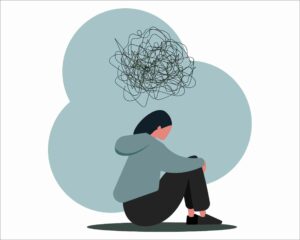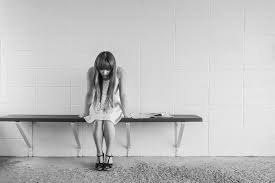Depression can be a very serious issue. It can lead to suicide in some cases, and it should never be taken lightly. However, depression does not always look the same in everyone. There are different levels of depression, and it is important to know how to recognize them. In this blog post, we will discuss the different levels of depression and what you can do if you think you or someone you know is suffering from it.
Contents
What Is Depression?
 Depression is a mood disorder that can cause serious symptoms. It affects how you feel, think, and handle daily activities such as sleeping, eating, or working. Depression can lead to a host of emotional and physical problems and can decrease your ability to function at work or home.
Depression is a mood disorder that can cause serious symptoms. It affects how you feel, think, and handle daily activities such as sleeping, eating, or working. Depression can lead to a host of emotional and physical problems and can decrease your ability to function at work or home.
While depression isn’t a “normal” part of aging, the risk of developing it increases with age. That’s because many of the physical, emotional, and social changes that come with aging can increase your vulnerability to depression. In fact, one theory suggests that as many as 20 percent of older adults will experience depression at some point in their lives.
Therefore, it is important to be aware of the different levels of depression so that you can get the help you need. Because there are times when depression can be more serious, and even lead to suicide. With the right level of care, however, depression is highly treatable.
Different Levels Of Depression
This is often one of the first questions people ask when they think they may be depressed: how do I know if I’m just sad or if I’m actually clinically depressed? And it’s a valid question.
After all, we all feel down from time to time. But there are definite differences between sadness and depression, and it’s important to be able to recognize them. Depression is divided into three levels to help people better understand the condition and how it might be impacting their lives. Let’s discuss those three levels of depression:
- Mild
- Moderate
- Severe
Mild depression
It is also known as dysthymia and is characterized by having a depressed mood most of the day for at least two years. People with mild depression may have symptoms like fatigue, low self-esteem, and trouble concentrating. But they’re still able to function relatively well in their everyday lives. There are some types of depression that comes under this level, these are:
- Atypical depression- It is characterized by significant weight gain, oversleeping, and sensitivity to interpersonal rejection.
- Depression with short episodes- A person experiences periods of clinical depression that last for two or more weeks but are separated by at least two months without any symptoms.
- Persistent depressive disorder- As the name suggests, a person experiences depression that lasts for at least two years.
These are just a few examples, but it’s important to remember that depression comes in many forms. And just because someone doesn’t fit into one category doesn’t mean they’re not depressed. It’s always best to consult with a mental health professional.
Moderate depression
 This is characterized by a low mood that lasts for most of the day, accompanied by at least four other symptoms. These include poor appetite or overeating, insomnia or hypersomnia, low energy levels, poor concentration, and feelings of hopelessness. People with moderate depression may also have physical complaints such as headaches or digestive problems.
This is characterized by a low mood that lasts for most of the day, accompanied by at least four other symptoms. These include poor appetite or overeating, insomnia or hypersomnia, low energy levels, poor concentration, and feelings of hopelessness. People with moderate depression may also have physical complaints such as headaches or digestive problems.
Also, in this level of depression, there are some types that can be classified, which are the following:
- Psychotic depression: This is a severe form of depression in which people lose touch with reality. They may have hallucinations or delusions.
- Bipolar disorder: This is a type of depression that involves periods of mania or hypomania. During these periods, people may have increased energy and activity levels. They may also be more impulsive and reckless.
- Postpartum depression: This is a form of depression that can occur after having a baby. It is thought to be caused by hormonal changes, lack of sleep, and the stress of caring for a new baby.
- Seasonal affective disorder: This is a type of depression that occurs during the winter months when there is less sunlight. It is thought to be caused by the change in light exposure.
It is important to seek help if you think you may be depressed. Depression is a treatable condition, and there are many resources available to help people who are struggling with it.
Severe depression
It is the most debilitating form of the disorder and can cause a person to lose interest in all activities, withdraw from friends and family, and have thoughts of suicide. At this level of depression, it is vital to seek professional help.
Because severe depression can be so life-threatening, it is important to get help as soon as possible. It includes depression types, that are:
- Major Depressive Disorder- This is the clinical term for depression. Major depressive disorder is characterized by a loss of interest in activities, changes in weight or appetite, sleeping too much or too little, fatigue, inability to concentrate, feelings of hopelessness, and thoughts of suicide.
- Persistent Depressive Disorder- Persistent depressive disorder (PDD), also known as dysthymia, is a chronic form of depression. PDD is characterized by a low mood that persists for at least two years. In addition to the general symptoms of depression, people with PDD may also have trouble sleeping, feel exhausted, and have difficulty concentrating and making decisions.
All in all, these are the top three levels of depression that are divided into various types of depression. As you can see, each level has its own set of symptoms. If you or someone you know is experiencing any of these symptoms, it is important to seek professional help. Depression is a serious disorder that should not be taken lightly. With the proper treatment, however, it is possible to live a happy and fulfilling life.
What Are The Causes?
 There are many different causes of depression, and it can affect people of all ages. It is important to remember that depression is a serious illness, and should not be taken lightly. If you think you may be depressed, it is important to seek help from a professional. There are some common causes and a few triggers that affect levels of depression.
There are many different causes of depression, and it can affect people of all ages. It is important to remember that depression is a serious illness, and should not be taken lightly. If you think you may be depressed, it is important to seek help from a professional. There are some common causes and a few triggers that affect levels of depression.
Some people are more prone to depression than others. This can be due to a chemical imbalance in the brain, or it may be due to a combination of genetic and environmental factors. If you have a family member who is depressed, you may be more likely to experience depression yourself.
For example, someone who has low levels of serotonin (a neurotransmitter that helps regulate mood) may be more likely to experience depression. This can be due to a genetic predisposition or it may be the result of taking certain medications.
Other risk factors include having a history of abuse or trauma, having a chronic illness, or experiencing major life changes (such as a death in the family or losing a job). Some people may also be more likely to experience depression during certain seasons (such as winter) due to the lack of sunlight.
If you think you may be depressed, it is important to seek help from a professional. Because it is not always easy to recognize the signs and symptoms of depression, a mental health professional can help you determine if you are indeed experiencing depression.
How Can You Manage Levels Of Depression?
The different levels of depression can affect you in different ways, and it can be tough to cope with. However, there are some things you can do to help manage your depression. Let’s outline these tips to manage your condition.
Understand your level of depression
 First, it’s important to understand the level of your depression. Depression can be mild, moderate, or severe. It’s important to know which level you are at so you can get the appropriate help. Because each level is different and affects people in different ways, the treatment will be different as well. So, this can help you and your doctor creates a treatment plan that is right for you.
First, it’s important to understand the level of your depression. Depression can be mild, moderate, or severe. It’s important to know which level you are at so you can get the appropriate help. Because each level is different and affects people in different ways, the treatment will be different as well. So, this can help you and your doctor creates a treatment plan that is right for you.
Recognize the symptoms
The next thing to do is to be aware of the symptoms of depression. This can help you catch it early and get the help you need. Depression can cause a change in mood, energy levels, sleep, appetite, and concentration. With this, you can experience feelings of worthlessness, guilt, helplessness, and hopelessness.
Practice relaxation techniques
Relaxation is a key component of managing different levels of depression. Stress and anxiety can worsen symptoms, so it is important to find ways to relax. Some relaxation techniques that may help include:
- Deep breathing exercises: It is important to breathe from the diaphragm, or stomach area, rather than the chest. This type of breathing slows the heart rate and can help to lower blood pressure.
- Progressive muscle relaxation: This involves tensing and relaxing different muscle groups in the body, starting with the toes and working up to the head.
- Meditation: In addition to deep breathing, meditation can also help to focus the mind and clear away racing thoughts.
- Yoga: Yoga combines breathwork, movement, and relaxation. It can be a helpful way to reduce stress and improve overall well-being.
Lifestyle changes
There are some lifestyle changes that you can make to help improve your depression. Some common things are:
- Exercise is a great way to fight depression. It releases endorphins, which have mood-boosting effects. Exercise also helps to reduce stress and improve sleep. If you are not used to exercising, start with just a few minutes a day and work up to 30 minutes or more.
- Eating a healthy diet is also important. Eating foods that are high in nutrients and low in sugar can help improve your mood and give you energy. Limit caffeine and alcohol, as they can make depression worse.
- Getting enough sleep is crucial for managing depression. Most people need around eight hours of sleep a night. Create a bedtime routine and stick to it as much as possible.
Spend time outdoors
Depression is a serious mental illness that can have a profound effect on every aspect of your life—from the way you think and feel about yourself to the way you act and interact with others. Spending some time in nature or outdoors makes you feel better and relaxed. It also helps you to get away from your problems for a little while and think about something else.
Seek professional help
 In severe cases, these things might not be enough. You might need to seek professional help from a therapist or counselor. They are experts in dealing with depression and can help you develop healthy coping mechanisms. If you don’t feel like your situation is improving, or if it’s starting to affect your work or home life, then reach out for help. Depression is a serious issue and should be treated as such.
In severe cases, these things might not be enough. You might need to seek professional help from a therapist or counselor. They are experts in dealing with depression and can help you develop healthy coping mechanisms. If you don’t feel like your situation is improving, or if it’s starting to affect your work or home life, then reach out for help. Depression is a serious issue and should be treated as such.
So, there you have it. A brief overview of the different levels of depression. If you think you might be suffering from any level of depression, don’t hesitate to reach out for help. There are people who care and want to see you get better. You are not alone in this fight. Just remember, there is always help available. You just have to take the first step.
Conclusion
In conclusion, levels of depression are divided into mild, moderate, and severe. Each level has its own symptoms that can be recognized. It is important to get help if you are experiencing any level of depression. There are many resources available to help you get the treatment you need. With the right treatment, you can improve your quality of life and live a fulfilling life.
For more information and guidance please get in touch with our expert therapists at Therapy Mantra. They will be more than happy to assist you on your journey to recovery. Contact us today to learn more about our services. You can also book an online therapy session or download our free Android or iOS app.


